Common Software Development Methodologies

The software development methodology is the structured process of working on a software project. Furthermore, it combines pragmatic realism and design philosophies from the early days of computing. The goal of the process is to provide a systematic software development approach.
Different software development methodologies have been introduced through the years. They capitalize on the resources and technologies available, and the methodology provides a platform for developers to work more efficiently as a team. Moreover, it formalizes communication and determines how information should be shared within the development team.
IT companies nowadays all agree that a software development methodology is paramount for their team. But which model to choose remains a question, however. This is because many custom software development methodologies are available, and all have their advantages and drawbacks. Choosing which methodology to use depends on the software requirements, team structure, and business goals.
Agile Development Methodology
The agile methodology is one of the most popular software development methodologies recently. Agile has a different approach from the linear, traditional method, and rather than emphasizing rigid procedures and documentation, it focuses on satisfying users.
Tasks in an agile method are divided into short sprints, which take about one week to a month to complete. An iterative model involves several tests during the progression of the development process. Developers continue to seek customer feedback and perform software changes. In Agile, communication is the priority, particularly between software developers, users, and customers.

The approach is where developers design a disciplined software management process, providing room for some frequent changes. Furthermore, the methodology aims to minimize risks, which include cost overruns, bugs, and sudden changes in requirements. Agile requires a cultural shift in most organizations since it focuses on the clean delivery of individual parts of pieces of the software instead of the entire app.
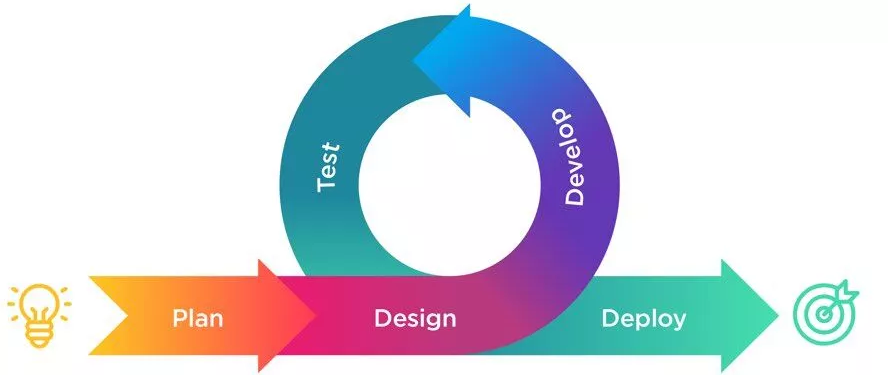
Image Source- Velvetech
Steps involved in Agile Methodology
The following are the agile methodology steps you should know.
-
General Planning Explaining the goal of the project by project managers is the first step. Furthermore, it explains the value of the organization or stakeholders and how it could be achieved.
-
Roadmap Creation Creating the project roadmap is the next step in the agile methodology. The roadmap could be described as a breakdown of all features to make up the final solution. This step is essential to be able to execute a project successfully.
-
Release Planning Agile revolves around sprints or shorter development cycles. Thus, every sprint is completed in a week or two at most. To complete a project quickly, however, it’s essential to define the date of release of every sprint, and the timelines should also be realistic.
-
Sprint Planning Before every sprint starts, a sprint meeting should be held. This meeting is essential for project managers and the team to be clear on the goals and objectives, how they would be accomplished, and how to manage the tasks. Task management software is an excellent tool for creating a visual workflow of tasks.
-
Daily Stand-ups Daily stand-up meetings are the same as a booster dose for the development team. These meetings are often short, lasting only from ten to fifteen minutes per day to discuss what the team has accomplished. The meetings are great for keeping the entire development team on the same page and resolving potential issues.
-
Sprint Review and Retrospective This is the last step in agile, which sometimes is not given much effort and time. However, if done regularly and correctly, it could help the team achieve more by boosting the processes. The goal of the review is to review the sprint goals, the feedback requests from stakeholders, and so on.
Benefits of Agile
- Clarity between the members of the team during the development process. Systematic and transparent development makes this possible.
- The software has minimal defects. This is because of the iterative effort in fine-tuning and testing.
- Scalable costs and schedules make it easier to foresee the costs and the legwork.
- Changes in the requirements are addressed quickly with agile. Furthermore, changes are worked on with less impact on the timeline.
- Agile has an adaptive approach, which allows for addressing any changes that the clients require.
Drawbacks of Agile methodology
- Sometimes, the team loses focus. This is because of the overwhelming change requests.
- Focuses on feedback and discussions. This could be too time-consuming for the development team.
- Documentation is not a priority with Agile. This could cause a problem later on in the development process.
- non-structured approach. The methodology requires developers who can work independently.
Waterfall Development Model
The Waterfall methodology is considered by many as the most traditional when it comes to software development. It’s a rigid, linear model consisting of sequential phases. These include the requirements, design, implementation, verification, and maintenance, which focus on specific goals.
Before starting the next phase, every phase should be 100 percent complete. Usually, there’s no process for going back to make changes or modify the project or the direction. Introduced by Dr. Winston W. Royce in 1970, the methodology is again the most traditional.
As a classic approach, the goals of the method are pre-defined for every phase of the development process. Being linear in nature, all projects progress in stages, and the completion of one stage will precede the next one. Waterfall is rigid since as soon as a stage is complete, there would be no reversible changes that could be done to the new requirements.
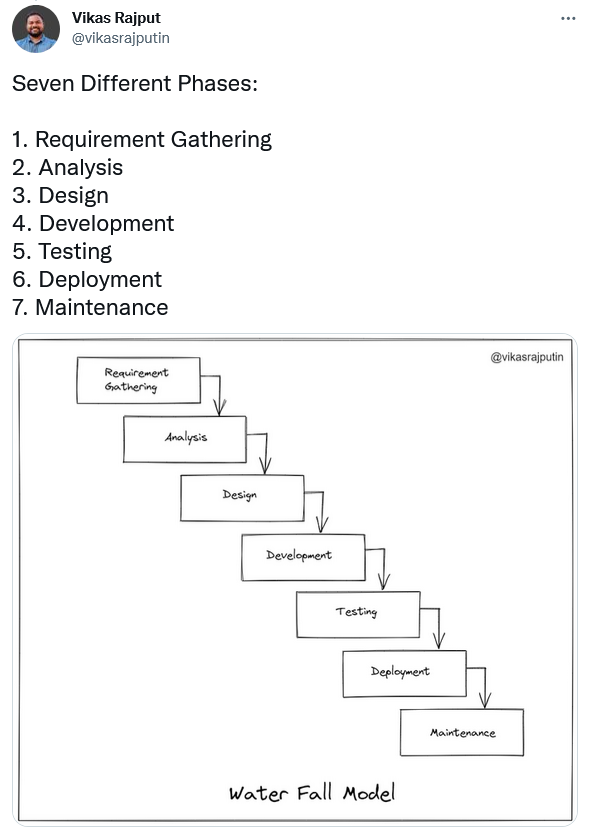
Steps involved in Waterfall Methodology
-
Defining the requirement It’s essential to know and understand what should be designed and developed, and the processes and their functionality. The phase provides input material to the solution being created.
-
Analysis step This step results in designing a schema, models, and business rules. It’s divided into two parts, the requirement and gathering, and analysis and the requirement specification.
-
Design Phase It helps specify software and hardware requirements for the design of the product. Furthermore, it helps in the overall system design architecture, and the design phase makes the overall architecture for the development project.
-
Implementation Phase The inputs from the design are taken and developed in small programs known as units, tested, and implemented in the next phase. The design is converted into a source code with completely functional program modules in this phase.
-
Testing and Integration Every design and development in the earlier steps is integrated from the implementation stage, which is incorporated into a system or module for different tests, such as load tests. Testing undergoes a constant check to determine if there is an error in the code or design.
-
System deployment/operations The software is deployed to the customer system or user or released to the market. This phase includes the user environment’s installation, migration, and support.
-
Product Phase The last phase but the most important of all in the waterfall model. This includes the creation of the right modification to the product or changing, improving, or changing attributes related to the performance concerns of the system.
Benefits of Waterfall
- Time-saving. The stages in methodology are processed and accomplished one at a time.
- Straightforward. It has no complexity in use and requires little or no experience.
- Easy management. Because of its rigid nature, each stage has a separate review process.
- Simple testing. This is because it’s based on the use cases defined in the technical specification.
- Clear structure. Because every step should be completed, determining possible errors is easy.
- High visibility. For both parties, transparency will not be a problem.
Drawbacks of Waterfall methodology
- Excludes the client and the user. It involves the internal process to help developers move forward. It does not encourage active client or user participation.
- Changes in rigidity. When implementing Waterfall, this is one of the most significant issues. You can’t backtrack to any changing requirements.
- Ideal for small and medium projects only, and it’s not suitable for long-term or research n development projects.
- Testing is done after completion. Saving the testing stage is risky.
Feature-Driven Development
Another iterative methodology combines object modeling. FDD is effective for big team projects. First applied in 1997, FDD was developed and refined by Jeff De Luca, Peter Coad, and others. Since then, it has become a pragmatic approach, ideal for complex, long-term projects looking for a simple yet extensive methodology.
Feature-driven development is an excellent option for teams looking for a focused, structured Agile methodology that could be scaled across the organization and deliver clear results. The method involves five steps: developing the complete model, creating a list of features, designing, planning, and building by feature.
Furthermore, FDD enables teams to update a project regularly and determine errors fast. In addition, clients could be provided with substantial results and information anytime. The methodology is a favorite among software development teams since it helps reduce confusion and rework.

Image Source - Productplan
Steps involved in Feature Driven Development
-
Overall model development The model describes the vision of the product, the context, and the target users.
-
Feature list creation This is the step where the team maps and brainstorms the specific features. The features are necessary to meet the objectives of the product to be developed.
-
Feature planning This step involves the breaking down of the features. Also, the step involves effort estimation, time, and set deadlines.
-
Designing This step entails an iterative design. Furthermore, it prioritizes the product’s features to be developed.
-
Creating the feature Cross-functional development teams iterate the development and testing of the product’s features. Helps reduce confusion and rework.
Benefits of Feature Driven
- User-centric approach. The end user is the client in this method.
- Requires fewer meetings. The feature-driven development methodology makes use of documentation to communicate.
- Perfect for big, long-term projects. FDD is very scalable and could grow as the company and project grow.
- Smaller feature sets. Feature sets are divided into smaller chunks, and regular iterative releases make it easier to track and fix errors in coding. It also minimizes risk and enables a fast turnaround to meet client needs.
- Provide an excellent understanding of the project scope and context. This makes the team work more efficiently.
Drawbacks of Feature Driven
- Not suitable for smaller projects. It does not work on a project with only one developer since it’s difficult for one or very few to take on the different roles without help.
- No written documentation. Has no written documentation to the client; thus, the client cannot get proof of their software.
- High dependency on the chief programmer. The chief programmer should act as a lead designer, coordinator, and mentor to the team’s new members.
- Does not work with older systems. This is because there is a system already, and there’s no overall model to define it.
DevOps Methodology
A development approach that helps software development and teams and operations function together. The two teams usually work in their silos, but DevOps lets them collaborate and foster the implementation from the design to the release. The methodology enables efficient communication between teams and provides ground for quickly creating, testing, and releasing a solution.
The software development approach ensures improved results and enables continuous delivery of products. DevOps is not just a methodology; it’s also a set of practices that support organizational culture. Deployment centers on organizational change, which boosts coordination between the departments responsible for various development life cycle segments.
These include the development phase, quality assurance, and operations. Working together, the development and operations teams could remove roadblocks and focus on boosting the development process. The goals of the methodology include fast development, fast quality assurance, fast deployment, and of course, faster time to market.
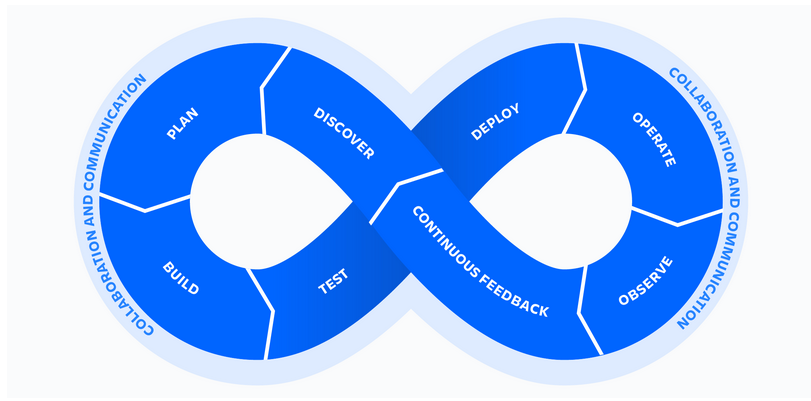
Image Source- Atlassian
Steps involved in DevOps Methodology
-
Planning Stage This is where tasks, schedules, and setting up project management tools are organized. The idea is to plan tasks with the user story process from agile. The step helps developers understand what development should be done and why.
-
Coding Developers perform code development and review. When the code is ready, it will be merged by the team.
-
Building the product The first step towards automation. The goal is to create the source code in the desired format. It also compiles, tests, and deploys in a specific place of the infrastructure.
-
Testing Continuous testing significantly minimizes risks. Furthermore, automatic testing ensures that there are no bugs.
-
Releasing The code has passed the test process. In this step, the product is now ready to be deployed.
-
Deployment The operation team deploys the new product. However, since one of the DevOps principles is automation, setting up continuous deployment is possible.
-
Infrastructure operation and configuration This stage is where the operations builder maintains a scalable infrastructure as code. Furthermore, it also helps check if there are security threats as well as perform log management.
-
Monitoring This is a crucial step. This enables you to fix incidents faster as well as create a better end-user experience.
Benefits of DevOps Methodology
- Faster deployment. Frequent and faster delivery of updates and features.
- Work environment stabilization. Improves the work environment with a well-balanced and steady approach.
- Automation. Automation in repetitive tasks provides more room for innovation.
- Significant quality enhancement. The collaboration between the development and operation teams lead to a significant improvement in the software product’s quality.
- Promotes business agility. With DevOps, obtaining scalability to transform a business is possible.
Drawbacks of DevOps Methodology
- Requires cultural change. Everyone in the organization should be on board and working together towards the same goal.
- Requires specific technologies and tools. Companies must invest in new tools and train their staff to use them.
- Challenging adoption. DevOps requires a lot of effort and time to get right; thus, it will take time to plan and test changes.
- Production environment in the cloud, which could result in compatibility problems and more complexity in the infrastructure.
Session Replay for Developers
Uncover frustrations, understand bugs and fix slowdowns like never before with OpenReplay — an open-source session replay tool for developers. Self-host it in minutes, and have complete control over your customer data. Check our GitHub repo and join the thousands of developers in our community.
Lean Development Methodology
This software development methodology focuses on developing low-budget software that’s change-tolerant. Lean maximizes resources through software development with one-third of funds, production time, and effort. The workflow is minimal.
With a workflow methodology and a mindset at the same time, Lean integrates practices and principles from manufacturing and applies them to different industries. Lean has several basic principles. These include optimizing the whole, building in quality, eliminating waste, creating knowledge, delivering fast, and so on.
Furthermore, it helps to guide the decision-making process across an organization in a way that could help determine possible issues and maintain a healthy culture. Lean makes it possible to acquire information straight from the source, and this eliminates the common issue of creating software that cannot address customers’ needs. Furthermore, lean methodology principles could be applied in any IT scenario for enhanced programming practices.
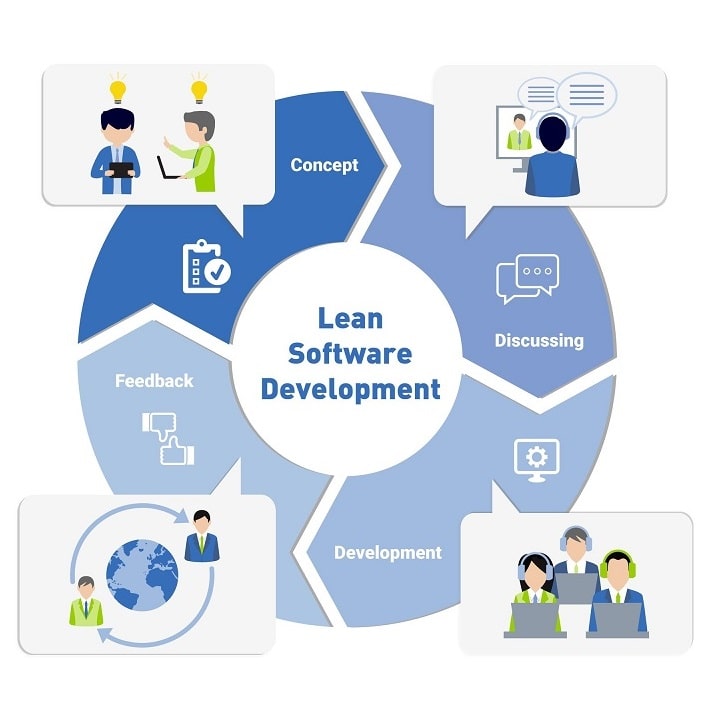
Image Source-Laneways Agency
Steps involved in Lean Methodology
-
Waste elimination One of Lean’s key elements is to remove anything that does not add customer value. Eliminating waste is critical in creating a product that provides excellent value to the customers.
-
Building quality Every development team wants to create a quality product. It’s essential to create and ensure the quality of the product being built.
-
Building knowledge Another principle that seems simple yet requires focus and discipline to implement. The principle furthermore encourages the teams to provide the infrastructure to document properly and retain valuable learning.
-
Deferring commitment This is one principle that’s easily misused. This does not mean that the development teams should be irresponsible about their decision-making. Instead, the principal encourages the team to demonstrate responsibility by keeping options open and collecting information continuously.
-
Fast delivery Every development team wants a faster delivery. Furthermore, faster delivery also entails the delivery of a product that does not have bugs and one that adds customer value.
-
Respect The principle of Lean is to respect people, often one of the most neglected. Respect for people, in principle, applies to every aspect of the operation, from communication to conflicts, hiring, and so on.
-
Optimization In software development, suboptimization is a serious concern. Often, it’s a self-fulfilling prophecy. Optimization means releasing a product that meets the quality requirements.
Benefits of Lean Development
- Empowers the development team. It motivates them to create acute decision-making abilities.
- Speeds up development. Most projects are done in a short amount of time, thus beating deadlines.
- Lesser cost. The overall development cost is less with the lean methodology.
- Faster time to market. Lean promotes efficiency; thus, the market time is significantly reduced.
- Increased motivation. The team members are empowered with more authority in the decision-making process.
- Cuts down on wastage. Lean reduces project waste, including unnecessary documentation, repetitive tasks, and redundant codes.
Drawbacks of Lean Development
- Restricted flexibility. This is to avoid unnecessary deviation and loss of time.
- Not suitable for less-skilled developers. Developers with fewer skills could be overwhelmed by the responsibilities and could lose focus on the development project.
- Requires adequate set skills and experience. The business analyst should have ample skills and experience to perform the requirements documentation properly.
- Lacks precision. Also, you need to keep track of the progress to ensure project success.
Prototype Methodology
The strength of this methodology is that it caters to all software engineering process lapses. Initially in this model, developers make a prototype of the solution. Furthermore, they visualize how it would run and prove its function to clients and investors.
Subsequently, developers make all the modifications needed in preparation for the development of the final app. This naturally provides room for understanding the software development requirements and performing useful business analysis. The model is used when customers have no idea what the exact project requirements are ahead of time.
In the prototyping methodology, a model of the end product is developed first, tested, and refined as per the customer’s feedback repeatedly until the final acceptable prototype is achieved. The system is implemented partially before or during the analysis phase, which gives customers a chance to see the product early in the development life cycle.
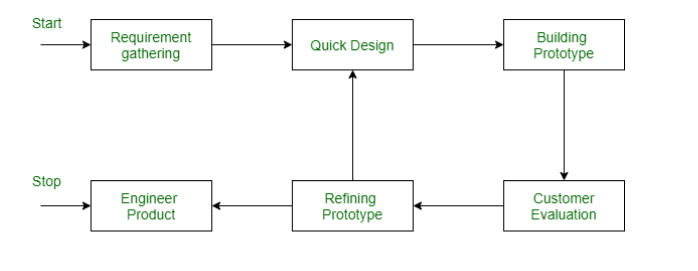
Image Source- GeeksforGeeks
Steps involved in Prototype Methodology
-
Analysis and Requirements gathering The first step in the prototyping model. In this phase, the desires of the system are defined precisely. Furthermore, the system users are interviewed to determine their exact system expectations.
-
Fast design This could consist of a quick or preliminary design. The basic design is formed in this phase, providing users with a quick product overview.
-
Prototype building The actual prototype is intended to support the knowledge gained from the fast design phase. The building of the prototype is a small low-level working model of the product desired.
-
Initial user evaluation The system proposed is presented to the client for preliminary testing. Checking out the strengths and weaknesses of the product is beneficial. Furthermore, during this stage, the feedback and suggestions of customers are gathered and forwarded to the team.
-
Prototype refining If the system fails to satisfy the user, it’s crucial to make improvements in response to the feedback and suggestions from users. When the satisfaction is finally met, a final system could be refined based on the approved final product.
-
Product implementation and maintenance This phase is where the system is thoroughly tested and distributed. To avoid downtime and prevent major failures, the testing is run regularly.
Benefits of Prototype Methodology
- Allows the identification of risks. It helps identify risks and correct errors during the initial development stages.
- Easy requirements gathering. The gathering of requirements and the analysis are easy if the document is absent.
- Easily scalable. Developers and testers could easily scale it, determine if they’re on point, and make the necessary changes.
- Best for demonstration. The methodology is the best way to present and demonstrate the software to an investor or a client.
- Promotes the relationship between the client and the developer, and it allows better bonds resulting from constant communication.
Drawbacks of Prototype Methodology
- Not market-ready. The initial result is never market-ready.
- Constant changes. This could lead to several alterations in the code as well as designs.
- Poor documentation. This is because of the continuous customer requirement changes.
- There could be sub-optimal solutions. This is because developers are in a hurry to create prototypes.
Spiral Model
The Spiral Model is a highly sophisticated software development methodology. Starting on a small scale, it encompasses the exploration of risks as well as providing plants to eliminate these risks. Then, it indicates if the next iteration level could commence.
In contrast to Waterfall, Spiral lets developers make changes in the code or the design, even in the testing phase. It’s a good fit for most projects but requires good management. Furthermore, the model combines an iterative development idea with controlled, systematic aspects of the Waterfall methodology.
The development process of the model begins with a small set of requirements and moves towards each phase for those sets of requirements. The engineering team adds the functionality for the added requirement in ever-growing spirals until the app is ready for production. The methodology helps adopt software development elements of different process models for the project based on unique risk patterns, which ensures efficiency.
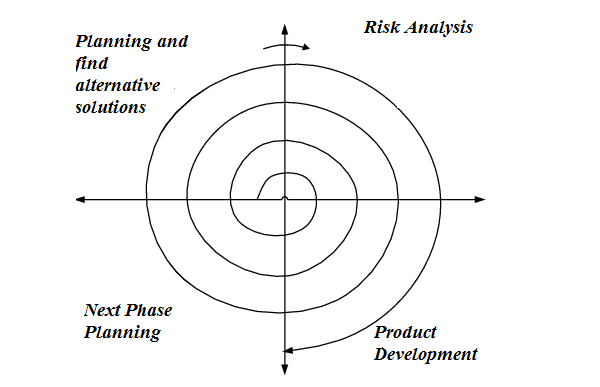
Image Source. Naukri
Steps involved in Spiral Methodology
-
Planning In this phase, project requirements are gathered and analyzed. Feasibility discussion will be observed.
-
Risk Analysis Risk is analyzed in this phase. Gathered requirements are analyzed, and then the risk is calculated. Once risk is identified, then risk mitigation strategies are planned.
-
Development Designing and coding take place in this step. Testing is also done.
-
Evaluation The developed software is evaluated in this phase, and clients submit their feedback. If everything is up to the mark, then they approve the product.
Benefits of Spiral Model
- Extensive risk analysis. This feature leads to very minimal risks on a project.
- Features and functions could be added even in the late testing stage. The model revolves around all the phases continuously; thus, it enables changes.
- Easy cost estimation. This is because the prototype building is performed in small fragments.
- Customer satisfaction. Customers are involved in product development at the early stage of the development process.
- Continuous development. It helps in risk management since it strictly adheres to the protocol.
Drawbacks of Spiral Model
- Expensive. That’s why it works for big projects and not for small ones.
- More complex. More complex than other models, and the process is complicated as well.
- Management difficulty. Since the number of phases is unknown initially, estimation could be tough.
- A large number of intermediate stages. This needs excessive documentation and makes it harder to define the objective and the verifiable milestones.
Conclusion
In this article we’ve gone through several methodologies; picking the right one for your needs is a key step that will spell success or failure for your project.

